High Strung
Page 3 of 5
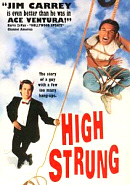
An open letter from Thane Furrows
To Whom It May Concern:
Well it's finally finished. "High Strung" has been written, produced, directed, edited, screened and tweaked. Now strange people, who have had nothing to do with the film's creation in any way, will step in and make every concerted effort possible to screw it all up. Isn't life grand? But that's a moot point now. The most important matter at hand is:
"High Strung" is about to be unleashed upon an unsuspecting world, and if this movie is a big hit, I will become a big celebrity. I'm sure this will be a nightmare for me. (But it will be a nightmare involving a lot of cash, and I'm convinced that if more nightmares ended with gigantic checks, they would be more readily appreciated.) I am prepared for "High Strung" to sweep through city after city, plex after multiplex like a tornado, helping everyone in its path to embrace cynicism. In light of all this "wonderfulness," I feel compelled to address a few small matters now, while I still have the time.
To the entire cast and crew... DO NOT CALL ME!
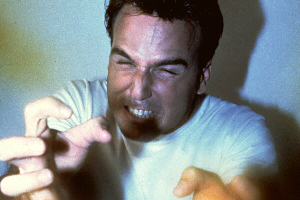
To the Russian producers... Now, aren't you happy that I arranged to keep you so occupied during production? And did you happen to notice that immediately upon the completion of principal photography, the Soviet Union crumbled? Sure, of course it was only a coincidence!
And to my fellow cynics, the critics... You can trust me! I understand! Big, successful movie reviewers are often too busy to cover every new breakthrough performer in depth, even unbelievably talented ones such as myself. You can take my word for it, this is NOT A PROBLEM! I have utilized my considerable skills as a writer to create a few really well-written quotes. After all, who knows more about "High Strung" than I do? Plus, it spares you the inconvenience of leaving your comfortable office, or bar, or wherever. No there is no need to thank me. However, should you ever need advice on writing for children, especially on successfully incorporating true-life tragedies into children's stories, I do accept commissions.
The quotes are as follows:
"Unbelievable funny to a degree never previously seen by man!"
"Steve Martin, look out! There's a new Steve in town!"
"I give it a 10, 10, 10!!!" (for Gary Franklin)
"I laughed so hard my eyes shot out the back of my head and killed an usher!"
Feel free to insert your own name as needed.
In closing, I would like to stress how enjoyable it is to contemplate the benefits the general public will derive from "High Strung". We all will be much better off and life will be so much more tolerable as soon as everyone realizes that life is, and always will be, INTOLERABLE.
Watch out for the edge,

"High Strung" - labeled too weird and too risky
It took several years and as many false starts for "High Strung" to reach the screen. In a business where many have to struggle to see their product reach fruition, the saga of "High Strung" is no exception.
Separate but parallel events led two teams to an eventual creative synergy... About twenty years ago in the Soviet Union, two successful musicians, Vladimir Horunzhy and Sergei Zholobetsky each spoke of their desire to one day travel to Hollywood and to make American-style movies. Over time, their paths took different directions and each, unbeknownst to the other, defected to the United States. Years later, a chance meeting in New York brought the two friends together again. Horuzhy had become a successful composer for film and television in Los Angeles and Zholobetsky had become the head of a multi-million-dollar corporation that he had built from the ground up in New York City. As the old friends reminisced, they recalled their early dreams of producing American-style movies. They decided to form Film Brigade Productions and began to look for the project that would turn their dream into reality.

As this took place in New York, Steve Oedekerk was in Los Angeles attempting to obtain the funds necessary to produce his and Robert Kuhn's script, "High Strung", an off-beat, irreverent comedy about a manic, motor-mouthed malcontent. Oedekerk hooked up with director Roger Nygard who submitted the script to Film Brigade. In one of life's major ironies, "High Strung", which had been labeled too weird and too risky by every American company it had been submitted to (more than two dozen), was exactly the type of American-style story the two Russians were looking for. "I couldn't believe it," Oedekerk recalls. "We had tried for so long to get this film made. Now this pair of expatriate Russians turn out to be the producers who understand High Strung's comedic point of view enough to give us the money to make it."
The considerable accomplishments of Nygard's award-winning short film, "Warped" (all of which had been achieved on a miniscule budget), convinced Horunzhy that Nygard could make a credible film out of Oedekerk's and Kuhn's script for the small amount of money that Film Brigade could afford to spend. "I felt very confident giving Roger the reins," Hurunzhy states, "and I was looking forward to scoring the inventive and entertaining movie that I knew he would make. I had no doubts."
Film was a new world for Zholobetsky. However, his involvement in "High Strung" was no mere whim, "I am a very cautious person by nature," Zholobetsky states. "I don't spend a dollar on anything I can't see, feel, or taste. So although this has been somewhat a leap of faith for me, I know how funny Steve Oedekerk is and I know he brought us a quality script to work from."
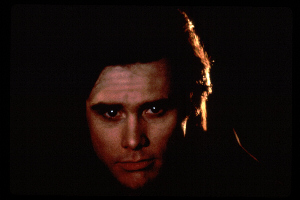
Once Film Brigade gave them the green light, Nygard and Oedekerk began to assemble a shooting script. Its original 107 pages had to be trimmed to 90. They couldn't afford to shoot anything more. Even then, there was absolutely no room for mistakes. "When Steve and I started to rework the script, we were amazed at how similar our notes were. In some instances, down to the same words," Nygard recalls. "It's lucky our visions were so similar. If we were to have any chance at all of keeping to our over-tight schedule, we would have to work closely together and trust each other."
Casting the film proved to be a relatively smooth process. "We signed all of our first choices," exclaims Nygard. "Primarily because of the script Steve Oedekerk was the only person ever considered as Thane. He created Thane. He sold the producers on Thane. Part of him actually is Thane." Through Oedekerk, Thomas F. Wilson agreed to play Al, Thane's best friend and another situation drawn from life. Nygard found Wilson's and Oedekerk's close friendship to be a decided advantage. "I simply put them together, rolled camera, and let them shine. It's the one place in the film where I was able to employ long takes without edits."
Thane's boss, Melanie, proved to be the film's most difficult role to cast. "We looked at forty-five different actresses for Melanie," casting director Ellie Kanner recalls. "The part called for quite a range: from some very subtle dialogue to a gigantic screaming match." Cinematographer Alan Oltman adds, "Denise Crosby's full-blown argument with Steve Oedekerk was exhausting. They kept it going for more than ten takes. I was drained just watching them."

Fred Willard was the immediate choice for the door-to-door insurance salesman. "His deadpan, easy-going yet over-the-top style was exactly what we were looking for," Nygard states. Willard responded immediately. "I loved it!" he recalls. "In fact, if we could have only gotten rid of Steve, I would have loved to play his role, too." Drawing from real life once again, Jani Lane, lead singer of the hugely successful heavy metal band, WARRANT, was picked to play Vol, Thane's thrash music-loving neighbor. "Jani has known a good number of real-life Vols over the years. He brought a strong feeling of authenticity to the role," Nygard states. "Jani's a smart guy, very observant, and very funny. He ad-libbed lines that were funnier than the script. He was a definite asset."
"High Strung" was filmed on an extremely limited budget in less than two-and-a-half weeks on a stage in Los Angeles. Producer Rubin Mendoza called upon his considerable commercial and music video experience to pull together the first-rate crew. "There was no room for error," he emphasized. "Everything had to run like clockwork or we'd go over budget. We had to have people we knew and could trust. With this crew, I never doubted for a moment that we would succeed." Production designer Richard London created Thane's loft-style apartment to be modern, light and appropriate to the story line. "We maximized our limited space by designing a lot of corners, angles, bricks, and wood," London explains. "We put in things like large pipes that jut out of the wall for no apparent reason to make it look real."
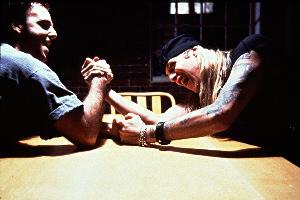
"Another considerable asset was the cooperation we all received from Steve Oedekerk," Mendoza continues. "High Strung is a dialogue-driven film and eighty percent of that dialogue had to be delivered by Steve. He was under constant pressure to deliver consistent performances under difficult conditions. He never wavered, and he never lost his cooperative spirit." Director Nygard brought in director of photography, Alan Oltman, to help achieve the unique visual style "High Strung" required. Oltman and Nygard devised ways to keep the camera moving to support the story's sense of urgency without busting their very limited budget. "I took the approach of brainstorming every possible way a scene could be shot," Nygard recalls. "I'd settle on a scheme, then I'd consider how the exact opposite of that approach would work."
"It was quite a challenge," Oltman states. "I used every idea I could think of while shooting in that room. It became almost a contest, to see how many different things we could do with the camera, a dolly, and some gaffer's tape. It's probably a good thing nobody from the [camera] rental house checked in on us."
Nygard and his crew managed to knock out between thirty-five and fifty-five set-ups each day. "We had no choice," first A.D. Tom Kranda explains. "You have to move fast if you intend to shoot a feature in only sixteen days. The shoot became a steaming locomotive we tried to keep under control. A lot of things did go wrong: parts of the set were still being built and painted as we were shooting on another part, which also prevented us from pre-lighting... the air-conditioning quit, raising temperatures to 105 degrees... malfunctioning effects had to be scrubbed... but, everybody pulled together and made it work. There was no wasted time!"
Once filming was completed, Nygard and editor Tom Siiter went to work. "High Strung" was the first feature cut on an EMC2, a new, non-linear, optical-disk editing system, Nygard explains. "We never touched a single piece of film. All of our footage was loaded into a computer and we viewed it on a video monitor. There were drawbacks. We were guinea pigs for a brand new system that didn't have all of its glitches worked out yet. But, its versatility and the world of choices it provided could have never been equaled with flatbeds and grease pencils.
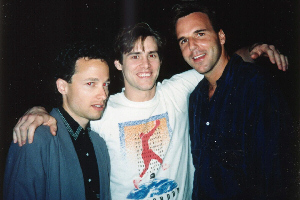
Once completed, "High Strung" was entered into a dozen film festivals, and experience the filmmakers found extremely satisfying. "This is what makes it all worthwhile," Horunzhy and Zholobetsky beamed after High Strung's premiere at the San Jose Film Festival. "It's terrific to watch and listen to the audience laughing and enjoying the film the way you imagined - no, hoped - they would."
To Whom It May Concern:
Well it's finally finished. "High Strung" has been written, produced, directed, edited, screened and tweaked. Now strange people, who have had nothing to do with the film's creation in any way, will step in and make every concerted effort possible to screw it all up. Isn't life grand? But that's a moot point now. The most important matter at hand is:
"High Strung" is about to be unleashed upon an unsuspecting world, and if this movie is a big hit, I will become a big celebrity. I'm sure this will be a nightmare for me. (But it will be a nightmare involving a lot of cash, and I'm convinced that if more nightmares ended with gigantic checks, they would be more readily appreciated.) I am prepared for "High Strung" to sweep through city after city, plex after multiplex like a tornado, helping everyone in its path to embrace cynicism. In light of all this "wonderfulness," I feel compelled to address a few small matters now, while I still have the time.
To the entire cast and crew... DO NOT CALL ME!

To the Russian producers... Now, aren't you happy that I arranged to keep you so occupied during production? And did you happen to notice that immediately upon the completion of principal photography, the Soviet Union crumbled? Sure, of course it was only a coincidence!
And to my fellow cynics, the critics... You can trust me! I understand! Big, successful movie reviewers are often too busy to cover every new breakthrough performer in depth, even unbelievably talented ones such as myself. You can take my word for it, this is NOT A PROBLEM! I have utilized my considerable skills as a writer to create a few really well-written quotes. After all, who knows more about "High Strung" than I do? Plus, it spares you the inconvenience of leaving your comfortable office, or bar, or wherever. No there is no need to thank me. However, should you ever need advice on writing for children, especially on successfully incorporating true-life tragedies into children's stories, I do accept commissions.
The quotes are as follows:
"Unbelievable funny to a degree never previously seen by man!"
"Steve Martin, look out! There's a new Steve in town!"
"I give it a 10, 10, 10!!!" (for Gary Franklin)
"I laughed so hard my eyes shot out the back of my head and killed an usher!"
Feel free to insert your own name as needed.
In closing, I would like to stress how enjoyable it is to contemplate the benefits the general public will derive from "High Strung". We all will be much better off and life will be so much more tolerable as soon as everyone realizes that life is, and always will be, INTOLERABLE.
Watch out for the edge,

"High Strung" - labeled too weird and too risky
It took several years and as many false starts for "High Strung" to reach the screen. In a business where many have to struggle to see their product reach fruition, the saga of "High Strung" is no exception.
Separate but parallel events led two teams to an eventual creative synergy... About twenty years ago in the Soviet Union, two successful musicians, Vladimir Horunzhy and Sergei Zholobetsky each spoke of their desire to one day travel to Hollywood and to make American-style movies. Over time, their paths took different directions and each, unbeknownst to the other, defected to the United States. Years later, a chance meeting in New York brought the two friends together again. Horuzhy had become a successful composer for film and television in Los Angeles and Zholobetsky had become the head of a multi-million-dollar corporation that he had built from the ground up in New York City. As the old friends reminisced, they recalled their early dreams of producing American-style movies. They decided to form Film Brigade Productions and began to look for the project that would turn their dream into reality.

As this took place in New York, Steve Oedekerk was in Los Angeles attempting to obtain the funds necessary to produce his and Robert Kuhn's script, "High Strung", an off-beat, irreverent comedy about a manic, motor-mouthed malcontent. Oedekerk hooked up with director Roger Nygard who submitted the script to Film Brigade. In one of life's major ironies, "High Strung", which had been labeled too weird and too risky by every American company it had been submitted to (more than two dozen), was exactly the type of American-style story the two Russians were looking for. "I couldn't believe it," Oedekerk recalls. "We had tried for so long to get this film made. Now this pair of expatriate Russians turn out to be the producers who understand High Strung's comedic point of view enough to give us the money to make it."
The considerable accomplishments of Nygard's award-winning short film, "Warped" (all of which had been achieved on a miniscule budget), convinced Horunzhy that Nygard could make a credible film out of Oedekerk's and Kuhn's script for the small amount of money that Film Brigade could afford to spend. "I felt very confident giving Roger the reins," Hurunzhy states, "and I was looking forward to scoring the inventive and entertaining movie that I knew he would make. I had no doubts."
Film was a new world for Zholobetsky. However, his involvement in "High Strung" was no mere whim, "I am a very cautious person by nature," Zholobetsky states. "I don't spend a dollar on anything I can't see, feel, or taste. So although this has been somewhat a leap of faith for me, I know how funny Steve Oedekerk is and I know he brought us a quality script to work from."

Once Film Brigade gave them the green light, Nygard and Oedekerk began to assemble a shooting script. Its original 107 pages had to be trimmed to 90. They couldn't afford to shoot anything more. Even then, there was absolutely no room for mistakes. "When Steve and I started to rework the script, we were amazed at how similar our notes were. In some instances, down to the same words," Nygard recalls. "It's lucky our visions were so similar. If we were to have any chance at all of keeping to our over-tight schedule, we would have to work closely together and trust each other."
Casting the film proved to be a relatively smooth process. "We signed all of our first choices," exclaims Nygard. "Primarily because of the script Steve Oedekerk was the only person ever considered as Thane. He created Thane. He sold the producers on Thane. Part of him actually is Thane." Through Oedekerk, Thomas F. Wilson agreed to play Al, Thane's best friend and another situation drawn from life. Nygard found Wilson's and Oedekerk's close friendship to be a decided advantage. "I simply put them together, rolled camera, and let them shine. It's the one place in the film where I was able to employ long takes without edits."
Thane's boss, Melanie, proved to be the film's most difficult role to cast. "We looked at forty-five different actresses for Melanie," casting director Ellie Kanner recalls. "The part called for quite a range: from some very subtle dialogue to a gigantic screaming match." Cinematographer Alan Oltman adds, "Denise Crosby's full-blown argument with Steve Oedekerk was exhausting. They kept it going for more than ten takes. I was drained just watching them."

Fred Willard was the immediate choice for the door-to-door insurance salesman. "His deadpan, easy-going yet over-the-top style was exactly what we were looking for," Nygard states. Willard responded immediately. "I loved it!" he recalls. "In fact, if we could have only gotten rid of Steve, I would have loved to play his role, too." Drawing from real life once again, Jani Lane, lead singer of the hugely successful heavy metal band, WARRANT, was picked to play Vol, Thane's thrash music-loving neighbor. "Jani has known a good number of real-life Vols over the years. He brought a strong feeling of authenticity to the role," Nygard states. "Jani's a smart guy, very observant, and very funny. He ad-libbed lines that were funnier than the script. He was a definite asset."
"High Strung" was filmed on an extremely limited budget in less than two-and-a-half weeks on a stage in Los Angeles. Producer Rubin Mendoza called upon his considerable commercial and music video experience to pull together the first-rate crew. "There was no room for error," he emphasized. "Everything had to run like clockwork or we'd go over budget. We had to have people we knew and could trust. With this crew, I never doubted for a moment that we would succeed." Production designer Richard London created Thane's loft-style apartment to be modern, light and appropriate to the story line. "We maximized our limited space by designing a lot of corners, angles, bricks, and wood," London explains. "We put in things like large pipes that jut out of the wall for no apparent reason to make it look real."

"Another considerable asset was the cooperation we all received from Steve Oedekerk," Mendoza continues. "High Strung is a dialogue-driven film and eighty percent of that dialogue had to be delivered by Steve. He was under constant pressure to deliver consistent performances under difficult conditions. He never wavered, and he never lost his cooperative spirit." Director Nygard brought in director of photography, Alan Oltman, to help achieve the unique visual style "High Strung" required. Oltman and Nygard devised ways to keep the camera moving to support the story's sense of urgency without busting their very limited budget. "I took the approach of brainstorming every possible way a scene could be shot," Nygard recalls. "I'd settle on a scheme, then I'd consider how the exact opposite of that approach would work."
"It was quite a challenge," Oltman states. "I used every idea I could think of while shooting in that room. It became almost a contest, to see how many different things we could do with the camera, a dolly, and some gaffer's tape. It's probably a good thing nobody from the [camera] rental house checked in on us."
Nygard and his crew managed to knock out between thirty-five and fifty-five set-ups each day. "We had no choice," first A.D. Tom Kranda explains. "You have to move fast if you intend to shoot a feature in only sixteen days. The shoot became a steaming locomotive we tried to keep under control. A lot of things did go wrong: parts of the set were still being built and painted as we were shooting on another part, which also prevented us from pre-lighting... the air-conditioning quit, raising temperatures to 105 degrees... malfunctioning effects had to be scrubbed... but, everybody pulled together and made it work. There was no wasted time!"
Once filming was completed, Nygard and editor Tom Siiter went to work. "High Strung" was the first feature cut on an EMC2, a new, non-linear, optical-disk editing system, Nygard explains. "We never touched a single piece of film. All of our footage was loaded into a computer and we viewed it on a video monitor. There were drawbacks. We were guinea pigs for a brand new system that didn't have all of its glitches worked out yet. But, its versatility and the world of choices it provided could have never been equaled with flatbeds and grease pencils.

Once completed, "High Strung" was entered into a dozen film festivals, and experience the filmmakers found extremely satisfying. "This is what makes it all worthwhile," Horunzhy and Zholobetsky beamed after High Strung's premiere at the San Jose Film Festival. "It's terrific to watch and listen to the audience laughing and enjoying the film the way you imagined - no, hoped - they would."
« Previous | 1 | 2 | 3 | 4 | 5 | Next »










